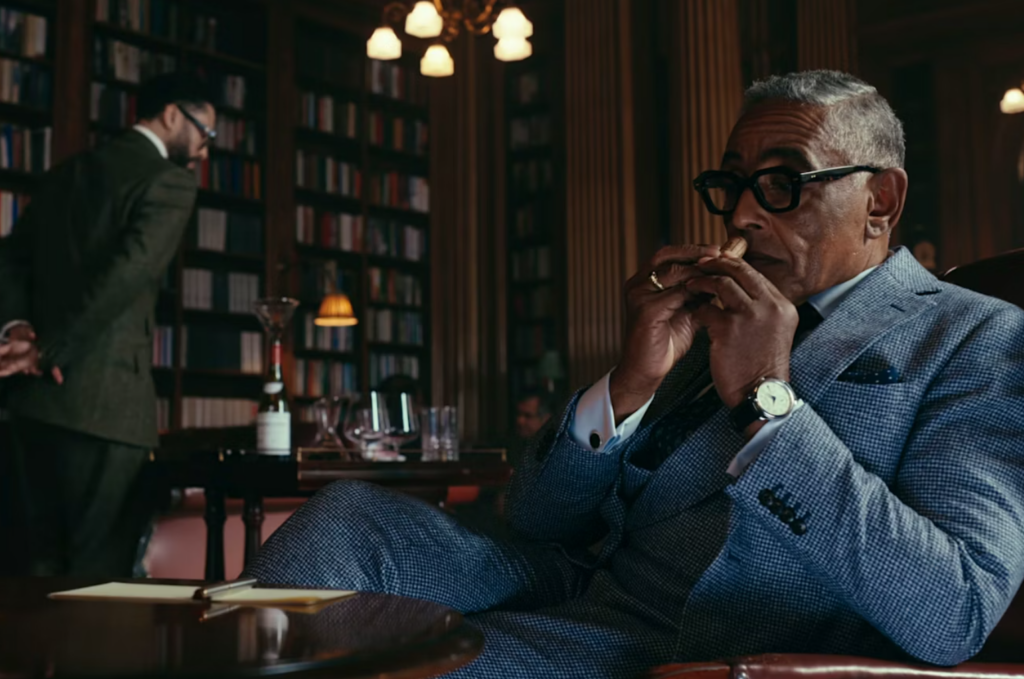
Forget Theo James for a moment, if that’s possible. The scene-stealer in the first episode of Netflix’s The Gentlemen is a bottle of 2002 Domaine de la Romanée-Conti.
I won’t bother to recount the storyline of The Gentlemen because, if you’re reading this, I’ll assume you’ve seen this Guy Ritchie-produced megahit. It seems everyone has, perhaps even more than once —it’s that good. Besides, I have a disdain for movie and book reviews that regurgitate the plot to meet some required word count before getting around to the actual review. Wine Spectator’s Owen Dugan almost did just that in his recent commentary. I clicked on the link with great enthusiasm, only to slog through several paragraphs of what I already knew before reaching the gist of his article, which was a dissection of this particular scene and what it meant to the wine world. In my best British accent, I said aloud, “Owh, cut to the chase, you bloody bloke!”
For me, The Gentlemen was like a bar of To’ak chocolate that I wanted to devour in one sitting. Instead, I exercised incredible willpower and allowed myself one mouth-watering episode per day, until there were just two left and I could no longer refrain. I binge-watch the final episodes, savoring every moment. As the final scene closed, I felt both deeply saddened and elated by the hint of future episodes. The withdrawal symptoms were tough but short-lived. I pined for more Theo James. (What woman didn’t?) I wonder what Guy Ritchie might conjure up next for these colorful characters.
Back to the first episode. Almost subliminally (and sublimely) placed behind the edgy acting and clever dialog between Stanley Johnston (played by Giancarlo Esposito) and Eddie Halstead (James) is a cameo appearance by a bottle of DRC. Whoa! I would bet that every wine aficionado watching the decanting scene jumped for the remote, rewound, and paused again to first study the label and then scrutinize the scene with a growing sense of dismay.
The decanting scene in itself is appropriately eccentric. While I appreciate the ritual of decanting and its necessity when warranted, I grimaced when Mr. Johnston’s sommelier poured the wine through a coffee filter, then rinsed out the bottle with water to clean it of any residual sediment before returning the wine to the bottle. Who does that to a bottle of DRC?
In the scene, Mr. Johnston says, “I hope you don’t disapprove of the way I prefer my wine presented. In breaking with tradition, I like to decant and clean the liquid, clear the bottle of any sediment, then return the wine so it can be enjoyed in its original housing.” I think Eddie should have shot him for this, but he’s a self-professed Bordeaux man, so perhaps that helped him exercise restraint.
Filtering this wine through a coffee filter is like stripping away some of its character. Rinsing the bottle of sediment with water is akin to ripping off its roots. I found both to be a grossly disrespectful act to commit to a storied bottle of DRC. At that moment, I decided that Stanley Johnston was a card.
Back to Dugan. In his article, he recounts discussing this scene with WS senior editor and Burgundy taster Bruce Sanderson. Sanderson was quite diplomatic in saying he would never use a coffee filter. I felt vindicated. He did not mention the rinsing of the bottle but did note some other minor errors in the handling of the wine.
I’m sure it’s as difficult for wine professionals to watch TV shows about wine as it is for attorneys to watch legal shows, ER doctors to watch medical programs, and horse professionals to watch anything fictional involving horses. They find the errors and inaccuracies sometimes intolerable. That said, I agree with Dugan’s closing assessment of The Gentlemen: “It’s great to see a show pay such detailed attention to a thing we love and use it to drive character.”
— Jennifer Waitte
